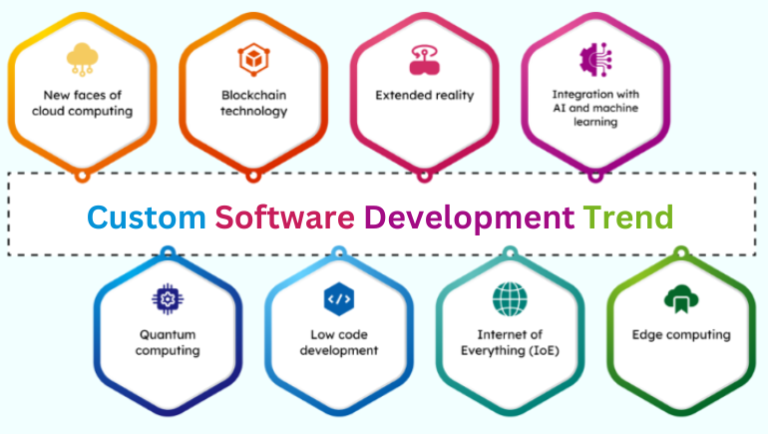Custom Software Development – Benefits, Trends, and Modern Practices

Table of ContentsToggle Table of ContentToggle
Custom Software Development – Benefits, Trends, and Modern Practices
The writing of custom software applications is the process of creating programs that meet the particular requirements of individuals or businesses. The difference between commercial off-the-shelf (COTS) software and bespoke products is that COTS software is not comparable to bespoke products. Unique designs are customarily made to address differential and varied situations. They are likewise used for inward use and not for sale.The Agile methodology is widely used in customized software program development. In addition, it employs a kind of micro service design that interfaces easily with current ones. Second, it gives continuous aid and security. We can take advantage of the app’s versatility as needed.
Custom software development comprises the process of development. It is designed to fulfil the distinctive needs and parameters of a company, institution, or person. Such development type usually implies teamwork with software developers and stakeholders. They install software solutions. They design, construct, test, and deploy software solutions. We target these solutions to specific problems or options. This technique provides benefits such as better security, scalability, flexibility, and customizable functionality, which are not easy to achieve with off-the-shelf software.
Custom software development involves the development and upkeep of customized software solutions that satisfy specific company requirements. It provides several advantages, including:
Tailored Solutions: Custom software is created to fulfill specific company requirements. It provides the most powerful skills and performances.
Scalability: It enables company expansion and adaptation to shifting needs. This does not cause repetitive replacements or migrations to other platforms.
Cost-Effectiveness: Custom solutions are frequently less expensive in the outset. Nonetheless, the system may have long-term cost benefits. This eliminates yearly licensing payments and the need for future software purchases. This causes the elimination.
Enhanced Security: Custom software can have specialized security features. This lowers the chance of vulnerabilities seen in off-the-shelf goods.
Personalization: Custom software allows for personalized experiences and can be designed to meet specific business operations. This improves productivity and provides a competitive advantage.
Step-by-step guide for custom software development:
This step-by-step lesson provides an overview of the bespoke software development process. It explains when to choose bespoke software. It deals with hiring a web development company. It covers the entire development lifecycle. It discusses advantages and recommended practices.
When using Custom Software Development: When a company needs software, it can either buy it turnkey or develop it custom. Software customization is the procedure of creating, building, and connecting customized software solutions. It is also the process of developing and updating the software. It satisfies completely the unique needs, targets, and objectives of a single business.
Hiring a Custom Software Development Company:
A company can either buy software product that is ready to use or develop custom when need arises. The custom development of software is the process of designing, programming, and integrating software systems. It also will updating the software. It will adjust to one business’s autonomous needs, objectives, and goals.
Expect During the Custom Software Development Life Cycle
The bespoke software development lifecycle is the series of activities that leads to the creation of software. The goal is to achieve the highest quality at the lowest feasible cost and in the quickest possible period. It gives a step-by-step process for assisting businesses in developing usable software. The idea creation phase flows into the delivery of the product/service. This life cycle focuses on the testing stage of the program. It is one that produces high-quality code while avoiding repeated tasks.
Ownership and Control
With bespoke software development services, organizations have complete ownership and control over the source code and the whole software ecosystem, allowing them to make updates and additions as required.
Agile Method for Custom software Development
Challenge in the custom Software Development:
These difficulties highlight the importance of rigorous planning, effective communication, and cutting-edge development procedures and technology. This is to address the problems associated with custom software development.
High cost and resource requirements
By adopting no-code choices that democratize app production, while decreasing financial pressures, the barrier of custom software development’s high cost and resource needs may be solved. This move makes bespoke software more accessible. It also fosters cooperation and innovation inside enterprises. Embracing these new possibilities leads to faster outcomes at cheaper costs. This creates a win-win situation. It allows businesses to stay competitive in today’s fast-paced technology world.
Lengthy development process
The development of custom software can be a time-consuming process. Traditional programming may include periods of extended cycles. They include planning, designing, coding, testing, and tuning before delivering the final product. Contemporary software is rather complex. Consequently, even minor changes may take up to weeks or months to implement. The development team gets frustrated with the slow pace. Delivering the final product late is another effect of it.
Difficulty in meeting changing business needs
Custom software development is important in today’s digital world. Firms must continually adapt and innovate to remain competitive. Traditional approaches can involve lengthy development cycles and restrictive processes. This makes it difficult to adapt rapidly to changing business requirements. But, no-code development systems provide a solution. They enable simple and rapid modifications, without requiring considerable coding or sophisticated processes. This enables firms to evolve and adjust their bespoke software as needed. It ensures that the software remains relevant to their changing demands. No-code platforms can provide enterprises greater control over their initiatives. Instead of relying solely on IT personnel or external developers, employees can use no-code tools to create and change their own apps. This allows non-technical personnel to actively engage in shaping.
Limited scalability and adaptability
Custom software development is predominantly faced with a lack of scalability and flexibility. Their businesses are extending and exchanging, so they tend to outgrow the existing software. This leads to inefficiencies, bottlenecks, and slow market responses. Old custom software development poses a challenge. It takes a long time to scale the product or adapt it to new needs. This makes for prolonged development cycles and the high cost of preservation. Additionally, if the business firm needs to make changes or updates to this system, it may have to depend on other developers or technical specialists. This will result in the increase of both the complexity and the fee.
Why no-code is the solution to these challenges
The costs associated with custom software development
Factors That Affect Custom Software Development Cost
Size of the application
Design and User Experience
This leads to long-term product enhancement, which boosts productivity all year round and saves you money. Using the old, complicated device decreases workplace engagement and production. Improving efficiency and navigability is the problem. But, a higher value/price trade-off for amazing UX/UI can be expensive and time-consuming. Outsourcing can be avoided if the firm does not specialize in software development. Developing in-house costs less. However, this initiative might require pulling some of your employees out of their regular work schedules. They would need to commit their full time to it. During the design phase, we predict and remove mistakes and flaws caused by the software system’s complex structure. We anticipate the challenges of the future software system. Consequently, the duration of this stage increases and requires qualified software architects. Multiple stages of testing are needed from the web development design, and QA phases for complex structures.

Latest trends in custom software development:
New facets of cloud computing
In a cloud environment the information stored and processed away from the local user. The tool comes made to lift the firm’s productivity. Cloud computing is on a fast-growing trend popularity especially among software developers due to their scalability, especially the ease of deployment and cost-effectiveness, and many more reason. This is important to note because it contributes to increased security, cost savings, a scalable system, and trustworthy services.
Block chain technology:
It is not only emerging as the key enabler in this industry. It is also currently the game-changer in a variety of fields, from software solutions to service delivery. The blockchain is a decentralized, safe, and transparent platform for storing and sharing information. It is popular with apps that demand high availability and security. In the forthcoming years, block technology will be a core part of enterprise software development. It will be used to deliver secure, decentralized solutions.
Extended reality:
Extended reality is a synonym for advanced technology. It includes Augmented Reality (AR), Virtual Reality (VR), and Mixed Reality (MR). These technologies cover a wide range of application areas. They provide users with immersive environments. Using XR in software design could pave the way for creating exciting and immersive apps. It could also enhance user experience.
Edge computing:
It is a proven distributed computing method. It permits that the statistics processing and analysis take place at the statistics collection stage rather than centralized servers. Through edge computing companies can boost speed, reduce latency and ensure higher safety. Smart companies are taking advantage of the technology which is cloud computing. They, therefore, make it part of their custom software development practice. This will ensure that the apps run faster and are more efficient.
Integration of custom software development with AI and machine learning:
There are Technologies that are most heavily utilized during the software development process. Machine learning and artificial intelligence are included among ever-evolving technologies. AI-powered apps simultaneously enhances the performance and increases the efficiency. Machine learning is the process by which machines learn to identify recurring patterns. They also uncover valuable insights. It places the systems in a position to give the required solutions. Businesses can use it to automate workflow processes. This can increase productivity too. Our personalized concentration pill will help you choose the right words and thoughts. It will give you an edge over others. It’s for students preparing for an important exam. It’s for employees aiming to impress during a work presentation. It’s for language learners seeking to improve grammar and vocabulary.
Quantum computing:
It is a realm, but to interrupt out into the arena. It applies the quantum concept of operations to be extra accurate. This selection addresses issues that cannot be solved via normal computers. This can be a game changer for wholesale software program improvement. By using this approach, the time consumption of data evaluation, modeling, and optimization will be significantly decreased. Not the best, but there could be completely new perspectives.
Low code development:
Low-code app creation allows you to create apps with minimal coding. Low-code and no-code development platforms will significantly influence the development process. They will allow developers to construct powerful apps with very little coding expertise.
Internet of Everything (IoE):
The Internet of Everything seeks to link not only gadgets, but also processes, people, and data. This interconnection presents exciting new options for software development. It enables firms to employ automation and data at a bigger scale.

New facets of cloud computing
Custom software development in business:
Custom software development India:
India has become a global hub for customized software. It offers a pool of benefits to businesses. The country has a pool of over 4 million IT professionals. Its STEM education system is developed. It enables working with a skilled staff on custom software development projects. Indian software companies have developed many cost-effective service delivery methods for clients around the world. One key reason India is attractive for business is its low costs. Clients are drawn to Indian software development companies for three key reasons. Custom software development companies have cultural agility, highly skilled multilingual teams, and competitive pricing. Outsourcing software development to India provides a competitive edge. It offers low cost and access to a skilled workforce. It also provides quality maintaining, scaling, and a time zone advantage. It also offers efficient communication, creativity, and cultural fit. Additionally, the Indian government has provided leadership support and collaborated in the world marketplace. The growth of Global Capability Centers (GCCs) has also built confidence with global leaders. It has helped India become a competent partner in the software development sector. We design and develop custom software solutions that empower agencies to live ahead of their competition. Techno profiles companions with you from concept to execution, turning in top-notch software products within time, price range, and impeccable quality. As a top-rated custom software outsourcing employer in India, we provide a group of enormously experienced and professional developers to work with you on fixed initiatives or devoted resource leases. With customers in 45+ nations and delivering 1200+ initiatives, Techno Profiles has the right know-how for your subsequent undertaking. We are a nice software improvement business enterprise in India.
Conclusion:
About Author

Written By Darshan Saroya
Darshan Saroya, a senior web developer and technical content writer, has been developing custom projects for TechnoProfiles for 7+ years. His expertise lies in WordPress, Laravel, MERN, MEAN and custom web/app development.





